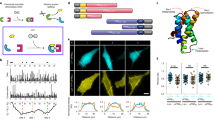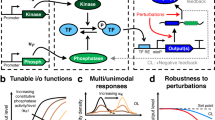Abstract
Chemically-inducible dimerization (CID) is a powerful tool that has proved useful in solving numerous problems in cell biology and related fields. In this review, we focus on case studies where CID was able to provide insight into otherwise refractory problems. Of particular interest are the cases of lipid second messengers and small GTPases, where the “signaling paradox” (how a small pool of signaling molecules can generate a large range of responses) can be at least partly explained through results gleaned from CID experiments. We also discuss several recent technical advances that provide improved specificity in CID action, novel CID substrates that allow simultaneous orthogonal manipulation of multiple systems in one cell, and several applications that move beyond the traditional CID technique of moving a protein of interest to a specific spatiotemporal location.



Similar content being viewed by others
References
Abe N, Inoue T, Galvez T, Klein L, Meyer T (2008) Dissecting the role of PtdIns(4,5)P2 in endocytosis and recycling of the transferring receptor. J Cell Sci 121:1488–1494
Bingol B, Wang CF, Arnott D, Cheng D, Peng J, Sheng M (2010) Autophosphorylated CaMKIIα acts as a scaffold to recruit proteasomes to dendritic spines. Cell 140:567–578
Castellano F, Montcourrier P, Chavrier P (2000) Membrane recruitment of Rac1 triggers phagocytosis. J Cell Sci 113:2955–2961
Csordas G, Varnai P, Golenar T, Roy S, Purkins G, Schneider TG, Balla T, Hajnoczky G (2010) Imaging interorganelle contacts and local calcium dynamics at the ER-mitochondrial interface. Mol Cell 39:121–132
Fegan A, White B, Carlson JCT, Wagner CR (2010) Chemically controlled protein assembly: techniques and applications. Chem Rev 110:3315–3336
Fili N, Calleja V, Woscholski R, Parker PJ, Larjani B (2006) Compartmental signal modulation: endosomal phosphatidylinositol 3-phosphate controls endosome morphology and selective cargo sorting. Proc Nat Acad Sci USA 103:15473–15478
Fivaz M, Bandara S, Inoue T, Meyer T (2008) Robust neuronal symmetry breaking by Ras-triggered local positive feedback. Curr Biol 18:44–50
Graef IA, Holsinger LJ, Diver S, Schreiber SL, Crabtree GR (1997) Proximity and orientation underlie signaling by the non-receptor tyrosine kinase ZAP70. EMBO J 16:5618–5628
Haruki H, Nishikawa J, Laemmli UK (2008) The anchor-away technique: rapid, conditional establishment of yeast mutant phenotypes. Mol Cell 31:925–932
Inoue T, Meyer T (2008) Synthetic activation of endogenous PI3K and Rac identifies an AND-gate switch for cell polarization and migration. PLoS One 3(8):e3068
Karginov AV, Ding F, Kota P, Dokholyan NV, Hahn KM (2010) Engineered allosteric activation of kinases in living cells. Nat Biotechnol 28:743–747
Karginov AV, Zou Y, Shirvanyants D, Kota P, Dokholyan NV, Young DD, Hahn KM, Deiters A (2011) Light regulation of protein dimerization and kinase activity in living cells using photocaged rapamycin and engineered FKBP. J Am Chem Soc 133:420–423
Komatsu T, Kukelyansky I, McCaffrey JM, Ueno T, Varela LC, Inoue T (2010) Nat Method 7:206–208
Li B, Desai SA, MacCokle-Chosnek RA, Fan L, Spencer DM (2002) A novel conditional Akt “survival switch” reversibly protects cells from apoptosis. Gene Ther 9:233–244
Liang FS, Ho WQ, Crabtree GR (2011) Engineering the ABA plant stress pathway for regulation of induced proximity. Sci Signal 4(164):rs2
Luik RM, Wang B, Prakriya M, Wu MM, Lewis RS (2008) Oligomerization of STIM1 couples ER calcium depletion to CRAC channel activation. Nature 454:538–542
Marshall CJ (1995) Specificity of receptor tyrosine kinase signaling: transient versus sustained extracellular signal-regulated kinase activation. Cell 80:179–185
Miyamoto T, DeRose R, Suarez A, Ueno T, Chen M, Sun T, Wolfgang MJ, Mukherjee C, Meyers DJ, Inoue T (2012) Rapid and orthogonal logic gating with a gibberellin-induced dimerization system. Nat Chem Biol 8:465–470
Mor A, Philips MR (2006) Compartmentalized Ras/MAPK signaling. Annu Rev Immunol 24:771–800
Phua SC, Pohlmeyer C, Inoue T (2012) Rapidly relocating molecules between organelles to manipulate small GTPase activity. ACS Chem Biol. doi:10.1021/cb300280k
Putyrski M, Schultz C (2012) Protein translocation as a tool: the current rapamycin story. FEBS Lett. doi:10.1016/j.febslet.2012.04.061
Rahdar M, Inoue T, Meyer T, Zhang J, Vazquez F, Devreotes PN (2009) A phosphorylation-dependent intramolecular interaction regulates the membrane association and activity of the tumor suppressor PTEN. Proc Nat Acad Sci USA 106:480–485
Robinson MS, Sahlender DA, Foster SD (2010) Rapid inactivation of proteins by rapamycin-induced rerouting to mitochondria. Dev Cell 18:324–331
Suh BC, Inoue T, Meyer T, Hille B (2006) Rapid chemically induced changes of PtdIns(4,5)P2 gate KCNQ ion channels. Science 314:1454–1457
Terrillon S, Bouvier M (2004) Receptor activity-independent recruitment of βarrestin2 reveals specific signaling modes. EMBO J 23:3950–3961
Ueno T, Falkenburger BH, Pohlmeyer C, Inoue T (2011) Triggering actin comets versus membrane ruffles: distinctive effects of phosphoinositides on actin reorganization. Sci Signal 4(203):ra87
Umeda N, Ueno T, Pohlmeyer C, Nagano T, Inoue T (2011) A photocleavable rapamycin conjugate for spatiotemporal control of small GTPase activity. J Am Chem Soc 133:12–14
Varnai P, Thyagarajan B, Rohacs T, Balla T (2006) Rapidly inducible changes in phosphatidylinositol 4,5-bisphosphate levels influence multiple regulatory functions of the lipid in intact living cells. J Cell Biol 175:377–382
Varnai P, Toth B, Toth DJ, Hunyady L, Balla T (2007) Visualization and manipulation of plasma membrane-endoplasmic reticulum contact sites indicates the presence of additional molecular components within the STIM1-Orai1 complex. J Biol Chem 282:29678–29690
Zoncu R, Perera RM, Sebastian R, Nakatsu F, Chen H, Balla T, Ayala G, Toomre D, De Camilli PV (2007) Loss of endocytic clathrin-coated pits upon acute depletion of phosphatidylinositol 4,5-bisphosphate. Proc Nat Acad Sci USA 104:3793–3798
Acknowledgments
The authors’ research was supported by NIH grants GM092930 to T.I. We regret that due to length considerations, we could not discuss many worthwhile papers that have appeared in the literature over the years.
Author information
Authors and Affiliations
Corresponding author
Additional information
This article is a submission for the special issue on “Recent Advances in Tools for Measuring and Manipulating Biochemical Signals and Mechanical Forces in Living Cells.”
Rights and permissions
About this article
Cite this article
DeRose, R., Miyamoto, T. & Inoue, T. Manipulating signaling at will: chemically-inducible dimerization (CID) techniques resolve problems in cell biology. Pflugers Arch - Eur J Physiol 465, 409–417 (2013). https://doi.org/10.1007/s00424-012-1208-6
Received:
Revised:
Accepted:
Published:
Issue Date:
DOI: https://doi.org/10.1007/s00424-012-1208-6




